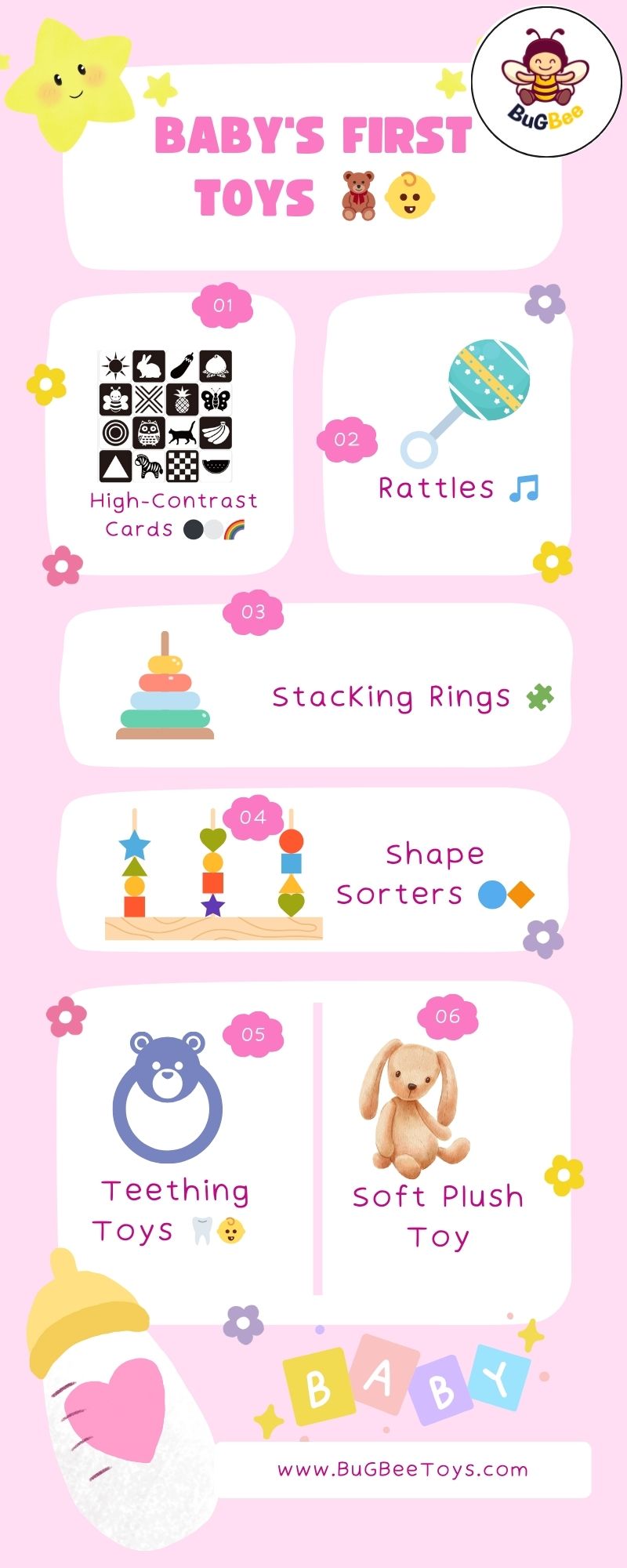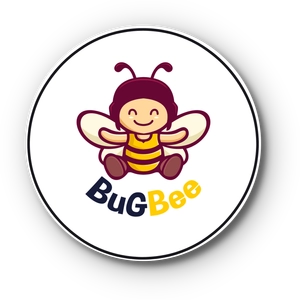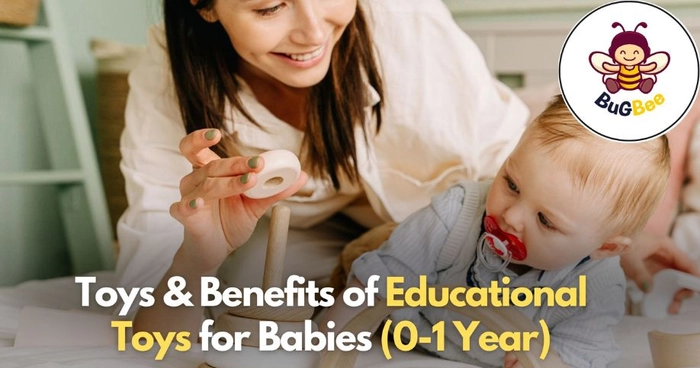In the world of parenting, there is a plethora of decisions to make, and one of the most crucial ones is selecting the right toys for your baby. When it comes to babies aged 0 to 1 year old, choosing educational toys can be a game-changer in their development. In this article, we'll explore why educational toys are essential for infants in their first year of life.
1. Early Cognitive Development
Babies are like sponges during their first year of life, absorbing everything around them. Educational toys designed for this age group are specifically crafted to stimulate a baby's cognitive development. These toys often incorporate bright colors, contrasting patterns, and different textures that engage a baby's senses and encourage curiosity.
2. Sensory Stimulation
Educational toys are carefully designed to engage a baby's senses. Toys with various textures, shapes, and sounds can help babies develop their sensory perception. As they touch, feel, and hear these toys, they begin to make connections between their actions and the world around them.
3. Motor Skills Development
During the first year, babies go through significant physical development. Educational toys can aid in the development of both fine and gross motor skills. Toys like stacking rings or textured balls can help babies practice their grasp and hand-eye coordination.
4. Language Acquisition
Language development is a vital milestone for babies. Educational toys that incorporate sounds, music, and words can play a crucial role in helping babies start to recognize and respond to language. Interactive toys that repeat words or phrases can be particularly effective in this regard.
5. Social Interaction
Even though babies at this age may not be talking yet, they are absorbing social cues from their environment. Educational toys that encourage social interaction, such as stuffed animals or interactive playsets, can help babies learn about emotions, facial expressions, and the concept of sharing.
6. Problem-Solving Skills
Simple educational puzzles and shape-sorters can introduce babies to basic problem-solving skills. These toys encourage them to explore and discover how things fit together, fostering a sense of accomplishment when they successfully solve a puzzle.
7. Emotional Development
Educational toys can also aid in emotional development by providing comfort and security. Soft, cuddly toys or blankets with different textures can become a source of comfort for babies and help them self-soothe.
8. Bonding Time
Playing with your baby using educational toys is not only fun but also an excellent bonding experience. It allows you to engage with your child, respond to their cues, and create precious memories together.
9. Long-Term Benefits
Investing in educational toys during the first year of your baby's life can have long-term benefits. It sets a foundation for a lifelong love of learning and exploration. As they grow, they will continue to seek out stimulating experiences and educational opportunities.

Here are some examples of educational toys that are suitable for babies aged 0 to 1 year old:
-
Soft Books: Soft, cloth books with bright colors and different textures are excellent for engaging a baby's senses and introducing them to the concept of books.
-
High-Contrast Toys: Toys with high-contrast patterns and colors, such as black and white or bold primary colors, can capture a baby's attention and promote visual development.
-
Rattles: Colorful rattles with various textures and shapes not only make noise but also encourage babies to grasp and shake, enhancing their motor skills.
-
Stacking Rings: These toys help babies develop hand-eye coordination and fine motor skills as they try to stack the rings on a central post.
-
Shape Sorters: Simple shape sorter toys challenge babies to match shapes with corresponding holes, promoting problem-solving skills and cognitive development.
-
Musical Mobiles: Hanging musical mobiles above the crib provide auditory stimulation and can be soothing for babies, helping them drift off to sleep.
-
Sensory Balls: Soft, textured balls with different patterns and materials are perfect for tactile exploration and sensory development.
-
Teething Toys: Teething rings or toys made of safe, soft materials can provide relief for teething discomfort while also being a source of sensory exploration.
-
Activity Gyms: These mats with hanging toys and mirrors encourage babies to reach, kick, and explore their surroundings, promoting physical and sensory development.
-
Interactive Plush Toys: Soft, interactive plush toys that play music, have lights, or respond to touch can captivate a baby's interest and encourage social interaction.
-
Baby Mirrors: Baby-safe mirrors allow infants to explore their own reflection, helping with self-recognition and visual development.
-
Nesting Cups: Stacking and nesting cups in various sizes introduce basic concepts of size and spatial relationships.
-
Baby Bouncers and Swings: These devices can provide a comfortable and secure environment for babies to observe their surroundings and engage with hanging toys.
-
Soft Building Blocks: Soft, squeezable building blocks are safe for little ones to play with and help develop their motor skills and creativity.
-
Sensory Board: A sensory board with buttons, switches, and different textures can keep babies engaged and stimulate their curiosity
10. Preparing for Future Learning
Lastly, educational toys for babies aged 0 to 1 year old prepare them for future learning experiences. These toys ignite a passion for discovery and critical thinking that will serve them well as they enter preschool and elementary school.
In conclusion, the choice of toys for babies aged 0 to 1 year old is not to be taken lightly. Educational toys offer a wide range of benefits, from stimulating cognitive development to promoting sensory perception, language acquisition, and problem-solving skills. They also play a crucial role in emotional development and offer excellent bonding opportunities for parents and their little ones. By choosing educational toys, you are not just providing entertainment; you are investing in your baby's future, setting them on a path of curiosity, exploration, and lifelong learning. So, next time you're shopping for toys for your little one, consider the numerous advantages of educational toys. Your baby's developmental journey will thank you for it.
FAQ'S :
1. What are Montessori toys?
- Answer: Montessori toys are educational toys that are inspired by the Montessori method of teaching. These toys are designed to encourage hands-on learning, independent play, and the development of essential skills such as fine motor skills, problem-solving, and sensory exploration. They are typically made from natural materials and are chosen to align with a child's developmental stage.
2. When should a baby have their first toys?
- Answer: Babies can start interacting with toys from birth. Initially, soft, high-contrast toys or toys with gentle sounds can capture their attention. As they grow, their toys can evolve to suit their developmental milestones and interests.
3. What toy is suitable for a 1-year-old?
- Answer: For a 1-year-old, choose toys that promote physical activity, sensory exploration, and problem-solving. Examples include stacking toys, shape sorters, musical toys, soft balls, and push-along toys.
4. What toys help babies learn?
- Answer: Toys that help babies learn include those that stimulate their senses, encourage motor skills, and promote cognitive development. Examples include rattles, soft books, textured toys, and toys that make sounds or play music.
5. What age is best to start Montessori education?
- Answer: Montessori education can begin as early as infancy with activities and toys that encourage independent exploration and learning. Many Montessori programs offer infant and toddler classes, but it can be beneficial to incorporate Montessori principles into your child's playtime from a very young age.
6. Are wooden toys better for babies?
- Answer: Wooden toys are often considered a good choice for babies because they are natural, durable, and safe. They also tend to have a simple design that encourages imaginative play and creativity. However, the choice of toys ultimately depends on the individual preferences and developmental needs of the child.
7. Are kids happy in Montessori education?
- Answer: Montessori education aims to create a nurturing and child-centered learning environment where children can explore, learn, and develop at their own pace. Many children thrive in Montessori settings and find joy in the freedom to choose their activities and engage in hands-on learning. However, like any educational approach, individual experiences may vary, and it's essential to consider the specific needs and personality of each child.


